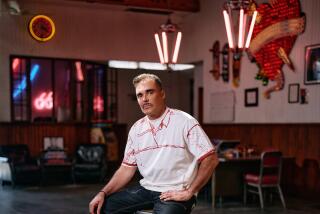Celebrities a Lucrative Angle for Photographers
- Share via
NEW YORK — Jacques Langevin has always worn his profession as a badge of honor--a “war photographer” who has risked his life covering such news events as war in the Middle East and events in Beijing’s Tiananmen Square.
This week, however, he has become an “untouchable,” as one colleague put it. A “shark,” a “paparazzo,” a “ghoul,” as newspapers labeled those photographers, including Langevin, who are under suspicion of contributing to the death of Princess Diana in Paris over the weekend.
“Everything seems so absurd and stupid,” Langevin told journalists after he was released from jail this week. “I’ve the impression of having fallen into a net.”
That net is spun with celebrity gold. News photography confers glamour and status, say veteran photographers, editors and photo agency executives. But it doesn’t pay the bills. For that, many photographers and photo agencies have turned to celebrities--or “le people,” as the photographers say in France.
“These days a newspaper that doesn’t do ‘people’ sinks,” said Jean Durieux, former editor in chief of Paris Match magazine.
“‘Photographers follow the market, and photo agencies and magazines have re-centered themselves around what we call ‘people,’ ” said Patrick Zachmann, Paris bureau president of the Magnum photo agency. “I was very surprised to find Jacques Langevin and other news photographers with them. Then again, I was only half surprised because of the changes in the market for pictures.”
The push toward celebrities has happened at the same time that news organizations have scaled back their photo budgets, according to several prominent photographers. To cover a war zone now, some freelance photojournalists find that they have to get a grant from a foundation or a private benefactor. Or they can travel “on spec,” using their own money and equipment and hoping they can sell the photographs when they return.
“The magazines and news organizations are more and more exploitative, especially of young photographers,” said Gilles Peress, an award-winning documentary photographer in New York. “They are not giving out as many assignments, and they have short-term contracts so that they won’t have to be responsible, won’t have to pay health insurance, etc.
“So young photographers stake their cameras and their lives to go off to Africa or to Bosnia, and maybe they can sell the pictures when they return or maybe they lose their lives, but it is not the responsibility of the news organization,” Peress said.
Chasing a superstar is a lot more lucrative. David M. Bodrick Jr., a 27-year-old who specializes in photographing the Kennedys, estimates that a normal photo of a famous subject “just walking around is not worth that much, maybe $100 to $2,000. But if it’s special, like Dodi and Di kissing, it starts at $500,000 on up.”
Such fees are not all that unusual, say those photographers working in this area. If it is exclusive and involves a top personality, bidding wars can start, with even U.S. tabloids offering $500,000 for hard-to-get shots like one of singer Michael Jackson.
Other photographers, like Bodrick, work on their own. When they get a “good shot,” they sell it directly to the tabloids. When the distribution of a photo gets to be too much work, it can go to an agency--which takes between 30% and 50% of the profit.
“It’s a tricky thing,” said New York photographer Lawrence Schwartzwald. “If you’re covering Princess Di, you might get that exclusive picture that’s worth $100,000, but maybe you’re working a year and spending a good deal of your own money on expensive travel and equipment. Most photographers don’t get rich. They hustle along; maybe they have a certain arrangement with an agency or somebody just to get by.”
Other photographers work more directly with their agencies, getting assignments and even working in shifts like salaried employees. Langevin, for example, was on duty Saturday night in Paris for Sygma and shot pictures at the Ritz Hotel when Diana and her party left.
He told reporters Wednesday that he then headed for a friend’s house along the same route Diana took and eventually came upon the accident scene. “I took some shots from about 15 to 20 meters,” he said. Police immediately confiscated his film and took him, five other photographers and a motorcycle driver into custody.
Photo agencies--such as Gamma, Sygma and Sipa--have felt the pressure as owners and investors want more profit than prizes.
“The managers and the little men in gray suits come in, and they make more of the decisions. Bottom line, productivity, profit--they are the key words now, and the pressure is terrific,” said Robert Pledge, president of the Contact Press Images agency in New York and Paris.
“The managers put pressure on editorial people, who in turn put pressure on the photographers. So, you then have this incredible race, this incredible competition for these celebrity photos,” said Pledge, whose agency is a smaller photographers cooperative. “Gradually it is taking over large segments of this business.”
Although cooperatives such as Contact and Magnum don’t do much celebrity work, the French agencies seem to spend a great deal of effort on pursuing the stars. According to the Paris newspaper Liberation, photos of le people now represent 50% of Gamma’s work and 35% to 40% of Sipa’s. The percentage is even higher for Sygma, the newspaper said.
Several U.S. executives suggested that the French and other European agencies are more aggressive about invading the privacy of film stars and international celebrities.
“Let’s be honest here. We are speaking of the French agencies,” said Ray Whelan, editorial director and part owner of Globe Photos in New York. “They are a tremendous supplier of the tabloids.”
Similarly, entertainment photographer Jim Smeal, who works with Ron Galella--famous for harassing Jacqueline Kennedy Onassis--said competition from Europeans in recent years “has really put a damper on the European market for some of us.”
Los Angeles and other areas have become “flooded” with what another photographer called “paparazzi wannabes.” They are young; they have a camera with a motor drive and long lens and plenty of time.
They wait and follow somebody famous and take up to 200 pictures in one frantic moment, hoping that they might get the one frame that will make them rich.
“It’s hard, but there’s big money to be made,” Smeal said.
Leading supermarket tabloids such as the National Enquirer, the Globe and the Star have said they will not buy or reprint photos of the accident that killed Princess Diana. And a number of U.S. grocery stores have said they will boycott publications that print them.
Said Paul Bernish, a spokesman for Kroger Co.’s 1,383 stores: “We have contacted our distributors and told them that if any future newspaper or magazine has pictures of the accident taken by the photographers that night, we will not put it out.”
Times staff writer John-Thor Dahlburg in Paris contributed to this report.
(BEGIN TEXT OF INFOBOX / INFOGRAPHIC)
The Big Players
In the highly competitive tabloid market, fees for hard-to-get shots of celebrities--such as Princess Di kissing Dodi Fayed--reach $500,000 and more.
Circulation in millions
UNITED STATES*
National Enquirer: 2.7
Star: 2.2
Globe: 1.0
****
BRITAIN
The Sun: 4.0
Daily Mirror: 2.5
Daily Mail: 2.0
****
GERMANY
Bild-Zeitung (Mon.-Sat.): 5.6
* U.S. tabloids published weekly; others are dailies unless otherwise indicated
Sources: Audit Bureau of Circulation; Benn’s Media; Editor & Publisher Yearbook
More to Read
Sign up for Essential California
The most important California stories and recommendations in your inbox every morning.
You may occasionally receive promotional content from the Los Angeles Times.










